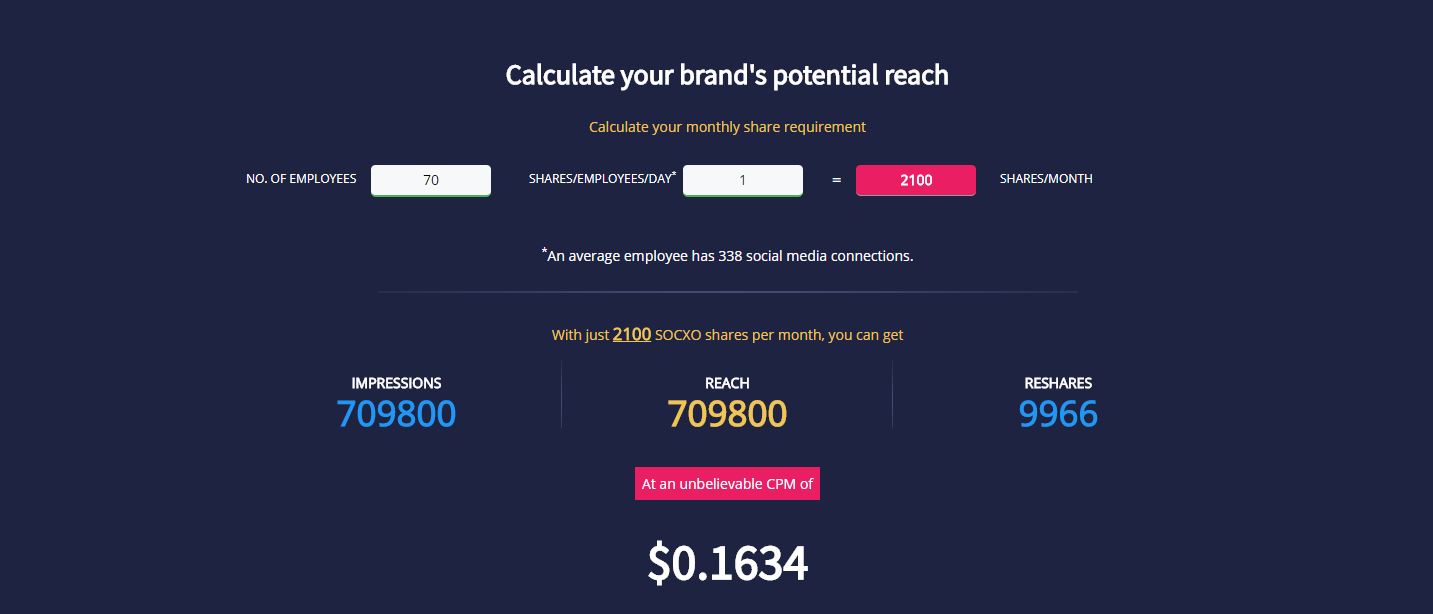In each of the last three #MartechMonday posts, we’ve focused on why influencer marketing is important and introduced you to several marketing tools that are great at helping you further leverage your customer advocates in getting the word out about your brand.
To finish off this four-part series on influencer marketing, this week I’ll be introducing you to three powerful solutions that can help you turn your employees into vocal advocates. In most of my marketing technology solution roundups, I follow a head-to-head review format, in which I individually grade each solution and help you identify the one that would work best for you.
This week I’m taking a slightly different approach though. These employee advocacy solutions that I’ll be covering are what I consider to be the three best tools of their kind — and feature for feature they are at near parity. That said, there are some differentiating factors that I’ll focus on. Instead of an arbitrary ranking of the solutions side by side, I’ll help you identify which solution will work best for you.
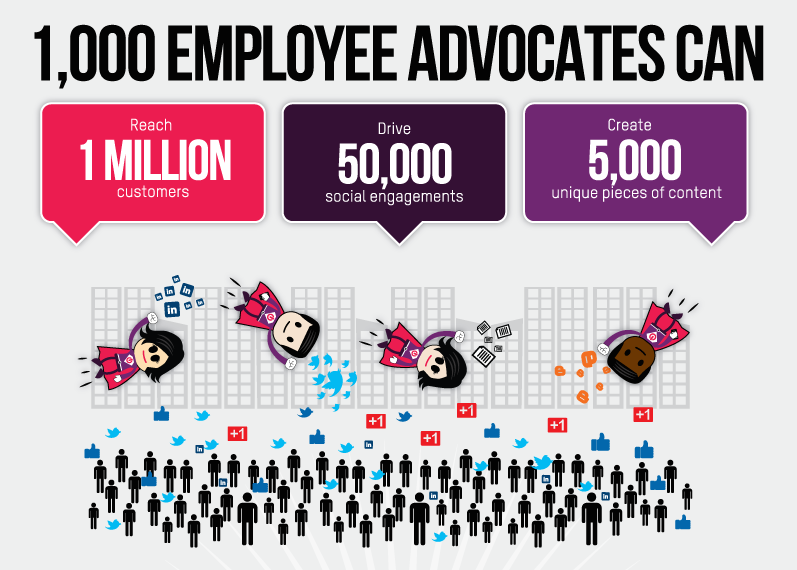
Source: Business2Community
But before we jump into today’s topic on employee advocacy, here’s a quick recap of this influencer marketing series:
- Three weeks ago we provided you with a simple guide to influencer marketing technology.
- Two weeks ago we compared three of the best influencer marketing community platforms.
- Last week we showcased an affordable (potentially free) gamification solution.
What is employee advocacy?
Companies always say that their human capital is their most valuable resource, and yet they often don’t treat them that way. In addition to providing employees with strong wages and benefits, companies also need to show their employees that their opinions count and that they are trusted. Employee advocacy programs are a superb way for companies to show they trust their employees and help them make their voices heard, not just inside of the organization but with potential customers as well.
Employees are often involved in your line of business even outside of work. For example, many employees are following your brand and topics relevant to your industry on social media. Also, your employees are likely already sharing content specific to your industry.
Employee advocacy is a practice whereby marketing organizations help employees across a company get the word out about the brand, and participate in meaningful online dialogue surrounding industry topics. Employees often have significant online assets (their Twitter profile, for example), and employee advocacy helps them leverage their online assets on behalf of your company. Employee advocacy solutions compile content that is favorable for your brand or helpful for thought leadership development, and then put that content in front of your employees so they can easily share it. As they share content they can earn points that can then be redeemed for rewards from your company.
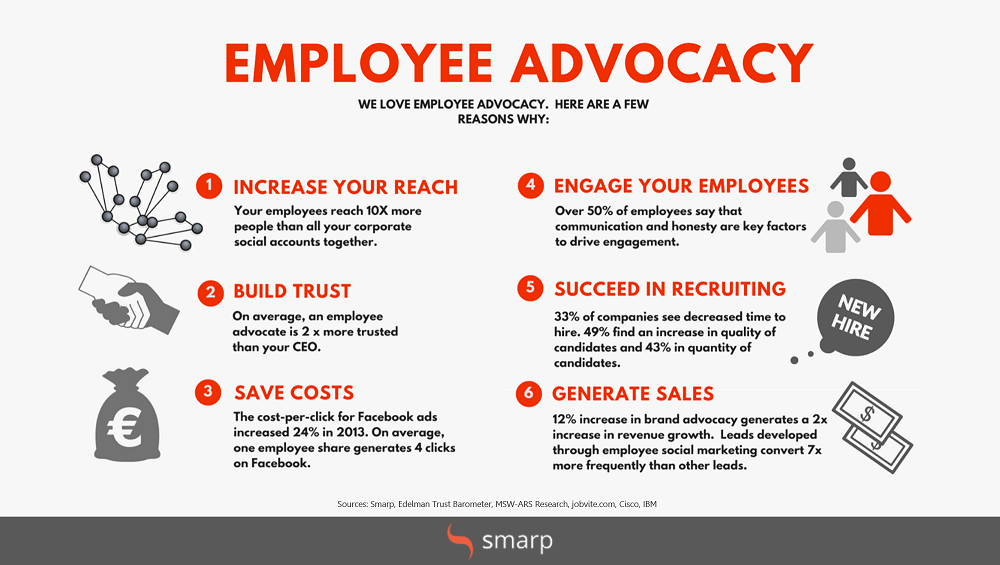
source: Smarp
Building an employee advocacy program isn’t very hard, especially if you leverage one of the three tools I’m showcasing here. However, to give you a brief look into what it takes to create an employee advocacy program, here are a few steps you’ll likely take on your journey:
1. Evaluate your employees “reach” and “influence”
Each of the three employee advocacy solutions I look at in this article have specific tools that help you easily measure the reach (how many followers a person has) and the influence (how trusted a person is) of your employees. That said, it is also valuable, before signing up for an employee advocacy solution and building out the full program, to determine if your employees have enough reach to make it worthwhile.
An easy way to do this is to ask your employees to follow the social media accounts of your company. From there you can click into each of your employee followers’ accounts and look at how many followers they have. If you’ve only got ten employees, and each employee only has a few dozen followers, an employee advocacy program probably isn’t for you.
2. Set your key performance indicators (goals)
What are the goals you have with your social media marketing efforts? Are you trying to gain new leads? Are you trying to win over customers so that they give you more money at renewal time? Are you trying to flood the market with favorable brand impressions?
No matter your goals, it is important that you have key performance indicators (KPIs) that help you measure those goals. Because social media marketing is such a large (and growing) field there are dozens of solutions that help you measure these KPIs. After you’ve selected the KPIs you want to measure, do a simple Google search for “tools to help me measure social brand influence” or whatever area you’re looking to measure and you’ll find dozens of great measurement tools.
3. Set up a solution to help you manage
In the sections below we cover three powerful tools that can help you earn employee advocacy social posts. Without a dedicated tool to help in this endeavor, getting employees to participate is like pulling teeth. You’ll find yourself sending emails or sharing messages on Slack… and you’ll see that not many employees will take any positive actions.
4. Gamify your employee advocacy program
I’ve seen employers set up employee advocacy programs before, but the programs went nowhere because the executive teams assumed that employees would share content just because they love the company so much. That normally is not the case. Employees may love your brand, but they are busy!
Gamification is a great way to get employees sharing content. You can track your employees’ social sharing and then give them points based on frequency, reach, etc. Once they earn enough points, they can redeem those points for specific perks: time off, company-branded swag, etc.
![]()
As you gamify the process you’ll see a considerably higher participating rate among your employees. Each of the employee advocacy tools introduced below has gamification functionality that makes this easy.
Martech Tools for Employee Advocacy
There are a dozen or so really good social media advocacy tools currently available. That said, of those I have direct experience with, the three listed below appear to have some of the greatest functionality that specifically targets employee sharing. Each has a robust portal that employees can log into, look through relevant and interesting articles, and then easily share out the content to their social media networks.
Because so much of the functionality is the same across each of these platforms, the below introductions will focus more on the unique selling points of each. You’ll also notice that I’ve got a section below, for each product, that highlights the certain kind of user that would most benefit from using that solution.
Smarp
Like each of the tools introduced here, Smarp prides itself on having an easy-to-use “news feed” — really a dashboard that employees can log in to see stories from your company that they can share.
User Dashboard: One nice component of Smarp is that you can post content to this news feed from your own blog, or from external sources. This is an important feature, as you’ll likely want to post other content that is relevant to your industry and not just content from your own blog. This way employees will feel like they have the option to be a thought leader while not just reposting all your own content.
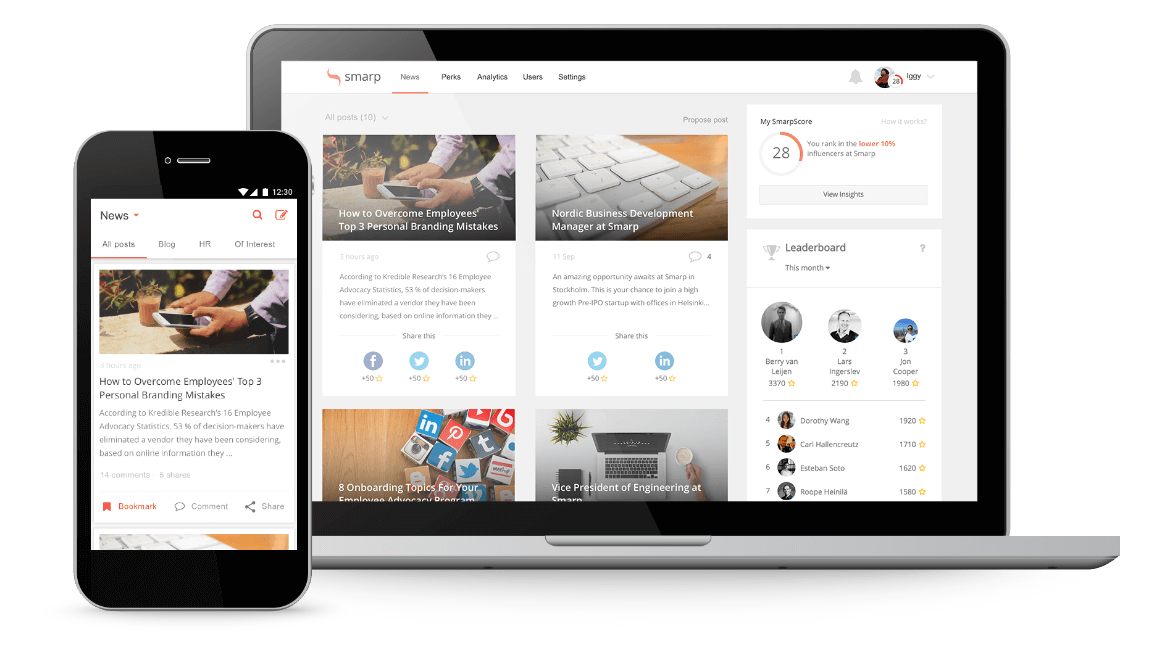
Of course, you likely do want employees to be able to easily share all of your own content, and as an administrator of Smarp’s tool, you don’t want to have to manually publish each of your own content pieces to the news feed. Thus, Smarp has created an auto-publish feature whereby you can insert an RSS feed (or a social media feed) and content that comes up in that feed will auto-post to your employee’s dashboard.
Gamification: Each of these three platforms has some great gamification built in, where your employees can share content to earn points that can then be redeemed for rewards. One component that is unique to Smarp, though, is that the Leaderboard is always present on the main dashboard for your employees. This way the competition is always top of mind.
Other Great Features: Another area where Smarp truly shines is in their supported networks. The supported networks they cover are especially valuable if you have a prospective customer audience that is globally diverse. Smarp supports the usual USA-based social networks of Twitter, Facebook, and LinkedIn, but also supports the globally diverse networks of Viadeo (big in Europe) and the three big Asian networks of Xing, Weibo, and WeChat.

Pricing: As for pricing, Smarp is kind enough to share some rough pricing details, though each contract is unique, and there is room for some negotiation when working with their sales reps. Smarp’s introductory package, which is actually quite robust and would work for most organizations as a starter platform, costs 3.5€ per employee per month. That is around $4 USD per month.
Who should use Smarp
Smarp’s feature set is similar to that of Sociabble and SOCXO, but they truly standout when it comes to supporting international social media networks. If you have a global business presence or expect to in the short-term, Smarp is likely the best solution for you.
Sociabble
Sociabble is a powerful, enterprise-ready employee advocacy platform that is being used by big brands such as Microsoft, Sage, PWC, and Allianz. In the below image I’ve mocked up the Microsoft instance of Sociabble so you can see what it looks like.
Similar to Smarp, Sociabble is built in Europe and has a relatively strong global presence. Its interface has translations already available for English and French, and they are working on additional language packs. What truly sets them apart though is their enterprise-ready feature set — mainly integrations for enterprise-class, third-party solutions.

Integrations: Sociabble brands itself as “enterprise-ready,” in large part due to its integrations with several powerful third-party software packages. The packages it has tight integrations with are Salesforce, Office 365, Yammer, Chatter, Damdy and several others. The big benefit here is that you can continue to use the tools your organization is already using and then sync them into Sociabble for better user and content management.
For example, if you are using Damdy for your video content management, then you can tie it into Sociabble to easily place shareable videos inside your employee’s dashboards. From there they can directly share that video content to their social media network.
Responsive Design: While each of the solutions has responsive design (meaning the app works on mobile phones, tablets, and full monitors) Sociabble appears to have the most fluid and easy to digest design.
Pricing: Sociabble doesn’t disclose their pricing, but in my experience, it is very comparable to Smarp’s pricing — so around $4 USD per employee per month.
Who should use Sociabble
If you are a larger organization and need to integrate your employee advocacy solution with third-party tools, such as Curata and SalesForce, then you should take a look at Sociabble.
SOCXO
Like Sociabble and Smarp, SOCXO is an excellent platform for getting shareable content in front of your employees and then rewarding them as they post that content to their social media networks. Two areas where SOCXO stands apart are in team-based gamification and human resource referral features.
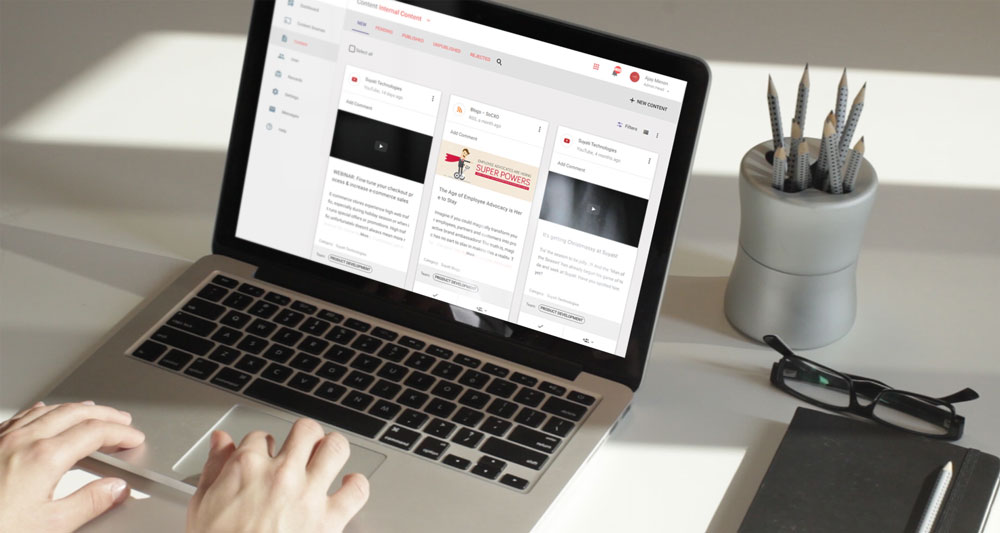
Team Gamification: One feature that is unique to SOCXO is the ability to create competitions for teams vs just for individual employees. The great benefit here is that you can strengthen department ties, or even build cross-department collaboration by bundling individuals together for certain competitions. As they earn points for sharing, each individual benefits from their own points but are adds to a collaborative pool for a total team prize.
Human Resource Referrals: Social media employee advocacy platforms such as SOCXO not only help engage current employees so they are more loyal to your brand, but they can also help you recruit new employees. This is one feature that SOCXO has thoughtfully built into their platform: human resource managers can log into the tool and post content that asks for employees to share about new job openings. This way your current workforce gets to participate in recruiting new employees and helps you get the word out about new jobs.
Pricing: One big advantage that SOCXO has over the other two platforms is their transparent and equitable pricing. Instead of paying a monthly fee for each employee you have on the platform, you pay a “per content share” rate. For example, if you think your employees will share around 900 posts a month, then you’d need to pay for their 1,000 share tier package, which is $64/month if paid annually. In addition to having transparent pricing, SOCXO also has a fabulous potential reach calculator that will help you determine what kind of reach you’re going to get from your employees and what you’ll pay SOCXO for that reach.
Who should use SOCXO
Most of my clients are small- or medium-sized businesses that provide software as a service. For these clients I generally recommend SOCXO, as it is affordable, easy to set up, and still provides a robust feature set.
